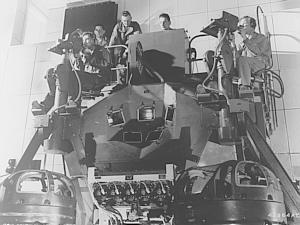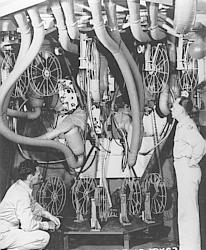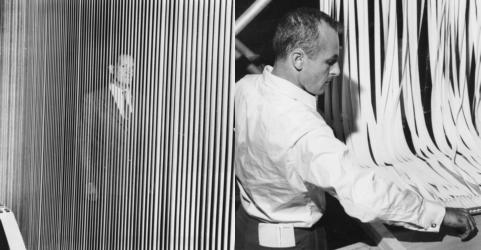|
| cinerama |
|
Vitarama Goes to War
When the Vitarama was rejected
by fair organizers as “too radical”
Fred, disciplined inventor that he
was, simply moved on to phase
two – five 35mm cameras
arranged 2 over 3. With war
looming in Europe, Waller
adapted his idea to an extremely
practical use – an aerial gunnery
trainer, which saved fuel, freed up
pilots and aircraft for actual
combat and eliminated the very
real problem of unskilled gunners
hitting the aircraft and not the tow
target. Since shooting at a slowly
towed target didn’t begin to mimic
actual battle conditions, most
gunners never really learned their
job until they were in actual
combat – and casualties were
high. With war
looming in Europe, Waller
adapted his idea to an extremely
practical use – an aerial gunnery
trainer, which saved fuel, freed up
pilots and aircraft for actual
combat and eliminated the very
real problem of unskilled gunners
hitting the aircraft and not the tow
target. Since shooting at a slowly
towed target didn’t begin to mimic
actual battle conditions, most
gunners never really learned their
job until they were in actual
combat – and casualties were
high.
The Waller Flexible Gunnery
Trainer was the first virtual reality
experience – decades before the
term was coined. Trainees wore
headsets with actual battle and
engine sounds, and a
sophisticated photoelectric system
scored their hits on the
photographed planes diving in
from out of frame. So realistic and
effective was the trainer, that 1 hour was equivalent to 10 of real
flying practice. The first group of
graduates hit 80% of their combat
targets and suffered no losses. At
the end of the war, it was
calculated that over 350,000 lives
were saved by the trainer.
Enthusiastic graduates wrote to
Waller, wanting to see this
amazing technology used in a
more commercial way.
hour was equivalent to 10 of real
flying practice. The first group of
graduates hit 80% of their combat
targets and suffered no losses. At
the end of the war, it was
calculated that over 350,000 lives
were saved by the trainer.
Enthusiastic graduates wrote to
Waller, wanting to see this
amazing technology used in a
more commercial way.
Waller, not surprisingly, was way
ahead of them.
The Secret of Oyster Bay
While installing the 75 gunnery
trainers contracted by the US Navy
and British Admiralty, research
and construction was still going on
at new facilities in an indoor
tennis court out in Oyster Bay,
Long Island. Reflections within the
sphere had been a real problem
on the trainer, so Waller dropped
the 2 upper cameras and
projected the remaining 3 images
– totaling 146° of horizontal angle
- onto a curved screen. But the
reflections remained, so the
screen was rebuilt as 1100 1”
vertical strips, all parallel to the
viewer. This solved the problem,
but made for a costly install.
The cameras and projectors were
also custom made, as the new
system used frames 6 perforations
high instead of the usual 4, and
ran at 26 frames per second
instead of 24. Total exposed
negative area was 6 times that of
a standard academy aperture. The
camera, while not the monstrosity
the 11-header had been, was still
a behemoth. Unblimped, it
weighed over 200 pounds and
made an awful racket. With its
lead-lined blimp, it tipped the
scales at 800 lbs. The lenses,
custom made by Kodak for Waller,
were the size of a contact lens,
with a focal length of 27mm – the
same as the human eye. Total exposed
negative area was 6 times that of
a standard academy aperture. The
camera, while not the monstrosity
the 11-header had been, was still
a behemoth. Unblimped, it
weighed over 200 pounds and
made an awful racket. With its
lead-lined blimp, it tipped the
scales at 800 lbs. The lenses,
custom made by Kodak for Waller,
were the size of a contact lens,
with a focal length of 27mm – the
same as the human eye.
This huge expanse of screen real
estate could hardly be
complemented by a standard
monophonic sound track, so
Waller brought in sound engineer
Hazard Reeves who developed a
7-channel discreet surround sound
system. To accomplish this, Reeves
invented fullcoat magnetic film –
the first use of magnetic media in
an optical sound industry. He
proved invaluable in another way.
When the Rockefellers and Time
pulled their funding, Reeves kept
the company afloat by buying the
assets – for $1600.
 Reeves made one other important
decision. He hired Mike Todd, a
Broadway showman who had yet
to produce a feature film, as his
Cinerama producer, reasoning
that his boundless enthusiasm and
sales ability was a necessary asset
to the new company. Todd also
had a relationship with Rodgers
and Hammerstein, and promised
to bring their hit musical
Oklahoma! to the new company to
be filmed in Cinerama.
Reeves made one other important
decision. He hired Mike Todd, a
Broadway showman who had yet
to produce a feature film, as his
Cinerama producer, reasoning
that his boundless enthusiasm and
sales ability was a necessary asset
to the new company. Todd also
had a relationship with Rodgers
and Hammerstein, and promised
to bring their hit musical
Oklahoma! to the new company to
be filmed in Cinerama.
One by one, heads of all the
majors trouped out to Oyster Bay
to see “Waller’s Wonder.” The 15
minute film included the roller
coaster at Rockaway Playland and
the Long Island Choral Society
singing the Messiah, which had
been recorded in the church, then
photographed to playback on a
set constructed at the tennis court.

Both were in black and white.
There were also traveling shots of
fall foliage and scenes aboard the
Rockefeller yacht, which marked
the first use of the new Kodak
monopack color negative film.
Impressed as they were
(instinctively turning around as the
choir came in on the rear
surrounds) they nonetheless knew
that exhibitors would never endure
the huge conversion costs, and
correctly saw how impractical and
expensive it would be for regular
production. Compliments all
around for Fred - and no
callbacks.
Waller realized that if Cinerama
was to succeed, it would be
without the help – and financing –
of the established picture industry.
Fortunately, Waller’s Wonder had
some very important friends.
page 32 cinema technology - december 2002
|
|